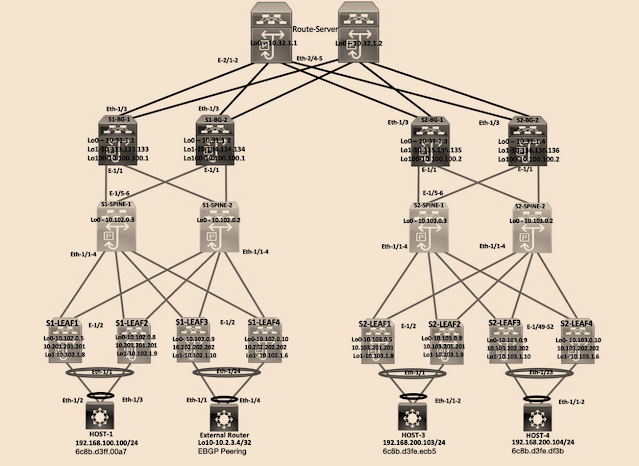EVPN: Ethernet VPNs discussion
EVPN: Ethernet VPNs discussion
Introduction
Ethernet VPNs (EVPNs)
have become increasingly popular in recent years, offering solutions to various
networking challenges. In this blog post, we will delve into the details of
EVPN, exploring its route types and how they are applicable in real-life design
and deployments.
The
Importance of Route Types
BGP EVPN route types
serve as the heart and soul of BGP EVPN and VXLAN fabric. Understanding the
construction and usage of these route types is crucial for comprehending how
the VXLAN fabric operates. While the system may seem complex, it replaces the
complexity of spanning tree, resulting in a more efficient network. In this
blog post, we will focus on six of the most commonly used route types.
Route
Type 2: MAC Advertisement Route
Route type 2 is the
most well-known route type in BGP EVPN. It is used for layer 2 switching and
allows for the advertisement of locally connected MAC addresses. By using route
type 2, MAC addresses can be used to establish connections within virtual
networks and create VXLAN fabrics as layer 2 transit networks. This route type
is also used for layer 3 connections and aids in reducing Layer 2 broadcast,
unknown unicast, and multicast traffic.
Route
Type 3: Inclusive Multicast Route
Route type 3 is used
for ingress replication, enabling the transmission of layer 2 broadcast,
unknown unicast, and multicast traffic over an IP-only network without
multicast enabled in the underlying network. In this case, unicast tunnels are
established between leaf switches, allowing for efficient forwarding. Route
type 3 is especially useful in scenarios where multicast is not available or
practical.
Route
Type 5: Prefix Route
Route type 5 is a
simple prefix route used for advertising locally connected subnets or external
subnets from the fabric. It is commonly used for advertising subnet information
within the fabric and can be used for advertising external subnets as well.
Route
Types 1 and 4: Ethernet Segment Routes
Route types 1 and 4
are used for standard-based Ethernet segment multihoming. They provide a
solution similar to Cisco's VPC multihoming but adhere to standard-based
protocols. Route type 4, also known as the Ethernet segment route, is used to
identify other members of the Ethernet segment connected to the same segment as
the advertising switch. It is also used to select the designated forwarder for
layer 2 broadcast, unknown unicast, and multicast traffic. Route type 1, or the
Ethernet AD route, is used for load balancing and aliasing. It helps balance
traffic between multiple devices and provides fast convergence and mask
withdrawal.
Understanding
the Control Plane
In the control plane,
the local virtual tunnel endpoint (VTEP) generates MAC advertisement routes and
exchanges them with remote leaf switches. These routes contain MAC and IP
address bindings, which are crucial for the functioning of EVPN. The control
plane also handles the advertisement and import/export of route targets,
ensuring the routes are installed correctly.
Understanding
the Data Plane
In the data plane,
traffic is routed between virtual networks within the tenant or virtual routing
and forwarding instance. This routing is facilitated by the advertisement of
host routes within the EVPN control plane. The MAC and IP address information
is shared between switches, allowing for efficient forwarding of traffic.
EVPN for
Layer 2 and Layer 3 VPN Services
EVPN can be used for
both layer 2 and layer 3 VPN services. While it is primarily designed for layer
2 VPNs, it can also be utilized for layer 3 VPN services using route type 5.
This allows for flexible deployment options and the ability to tailor the
network to specific requirements.
The
Benefits of EVPN
EVPN offers numerous
benefits, including: 1. Efficient traffic forwarding: EVPN replaces the
complexity of spanning tree with a more efficient forwarding mechanism,
allowing for faster convergence and reduced broadcast traffic. 2. Scalability:
EVPN provides a scalable solution for interconnecting large networks, making it
ideal for modern data centers and cloud environments. 3. Multicast and unicast
support: EVPN supports both multicast and unicast traffic, allowing for
flexible deployment options based on network requirements. 4. Improved network
visibility: The use of route types and the control plane allows for improved
visibility and control over the network, making troubleshooting and management
easier.
Conclusion
EVPN is a powerful
solution for modern networking challenges. By understanding the various route
types and their applications, network engineers can design and deploy EVPN
networks that are efficient, scalable, and tailored to their specific needs.
With its ability to handle both layer 2 and layer 3 VPN services, EVPN offers a
flexible and versatile solution for modern network environments.
- Cisco ACI Fabric APIC Discovery - The Network DNA
- Leveraging Cisco ACI APIC and MSO for Data Center Transformation
- Understanding the Physical Requirements of a Cisco ACI Solution
- Cisco ACI: DHCP Relay Support - The Network DNA
- Cisco ACI: Multi-Site Stretched Layer 2 (No-Flooding)
- Cisco ACI: Multi-Site Stretched Layer 2 (Flooding)
- Cisco ACI: Multi-Site Stretched Layer 3
- Cisco ACI: Control Plane components
- Cisco ACI : VMM (Virtual Machine Manager)
- Cisco ACI Infra: ASAv (Adaptive Security Virtual Appliance)












